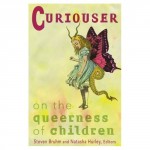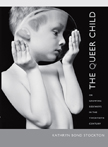Time to start putting together my syllabi for the spring. I am excited to teach “Feminist and Queer Explorations in Troublemaking” again. As always, I plan to mix up the readings a lot. I am not quite sure what I will keep. One topic that I want to take up is troublemaking and “the child”/children. Here are two sources that I am thinking of using:
 1. Curiouser: on the queerness of children
1. Curiouser: on the queerness of children
Edited by Steven Bruhm and Natasha Hurley
This authors in this collection are particularly interested in exploring what happens when we queer the dominant narrative of children as “innocent of sexual desires and intentions.” One way they envision queering this narrative is by interrogating how even as children are understood to not have sexual desires or engage in sexual practices, they are assumed (encouraged? required?) to be heterosexual. Another way they envision queering this narrative is by focusing on those (other/counter) stories “that make children ‘queer’ in a number of distinct ways and therefore are rarely told” (x). Here is how Bruhm and Hurley define queer, and its relation to the child/children, in their introduction:
The authors use the term queer in its more traditional sense, to indicate a deviation from the “normal.” In this sense, the queer child is, generally, both defined by and outside of what is “normal.” But the term queer derives also from its association with specifically sexual alterity. In this collection, the figure of the queer child is that which doesn’t quite conform to the wished-for way that children are suuposed to be in terms of gender and sexual roles. In other circumstances, it is also the child who displays interest in sex generally, in same-sex erotic attachments, or in cross-generational attachments (x).
I am not sure if I want to use the entire book or just a few essays? Hmm…. At first glance, there are several things that interest me about this collection:
- The link between queer, curious and children. I think being curious is a central part of troublemaking as a virtue. How does being curious get shaped and regulated through the creation or exclusion of narratives (cautionary tales?) of the queer child?
- The link between children, innocence and protection. How does this understanding of children as innocent (of certain knowledges about/experiences of the world) shape our vision of them as knowledge producers and critical thinkers?
- The specter of the queer (that is, not normal, not innocent–the troublemaker, perhaps?) child that haunts dominant narratives about and for children.
 2. The Queer Child, or Growing Sideways in the Twentieth Century
2. The Queer Child, or Growing Sideways in the Twentieth Century
by Kathryn Bond Stockton
Published this year, this book builds off of Stockton’s essay on queer children (included in Curiouser) entitled, “Growing Sideways, or Versions of the Queer Child: The Ghost, the Homosexual, the Freudian, the Innocent, and the Interval of Animal.” I don’t know much about this book (except that it includes a discussion of the Johnny Depp version of Willy Wonka and the Chocolate Factory which is, in my mind, is especially ripe for a queer, anti-capitalist analysis); I haven’t found a table of contents and it is checked out of the library right now. Should I assign this book, or a chapter from it, or just her essay in Curiouser? I don’t know yet…While I ponder that question, here is part of the blurb about it that I found on the Duke University Press website:
Engaging and challenging the work of sociologists, legal theorists, and historians, Stockton coins the term “growing sideways” to describe ways of growing that defy the usual sense of growing “up” in a linear trajectory toward full stature, marriage, reproduction, and the relinquishing of childish ways. Growing sideways is a mode of irregular growth involving odd lingerings, wayward paths, and fertile delays. Contending that children’s queerness is rendered and explored best in fictional forms, including literature, film, and television, Stockton offers dazzling readings of works ranging from novels by Henry James, Radclyffe Hall, Virginia Woolf, Djuna Barnes, and Vladimir Nabokov to the movies Guess Who’s Coming to Dinner, The Hanging Garden, Heavenly Creatures, Hoop Dreams, and the 2005 remake of Willy Wonka and the Chocolate Factory. The result is a fascinating look at children’s masochism, their interactions with pedophiles and animals, their unfathomable, hazy motives (leading them at times into sex, seduction, delinquency, and murder), their interracial appetites, and their love of consumption and destruction through the alluring economy of candy.
Wow. This does look really cool. I like the idea of sideways as an alternative to linear progression and “growing up.” I must order this book today!
Note: I have already discussed Lee Edelman’s No Future: Queer Theory and the Death Drive here. We are reading the first chapter at the end of this semester in my Queering Theory course. I will probably use it in the graduate seminar as well.
I need to keep searching for more sources to use. What about the feminist child? How can I think about the troublemaking child in relation to feminist theories about critical thinking, problem posing, and/or radical rebellion?

Comments are closed.